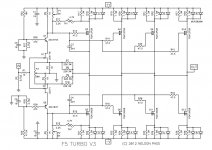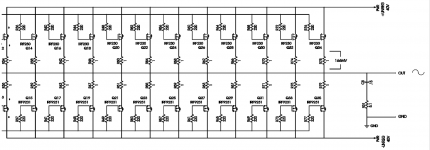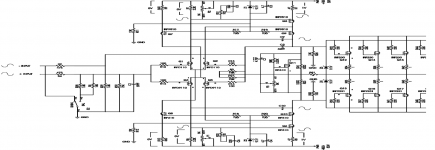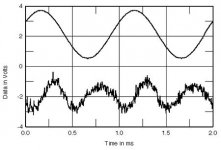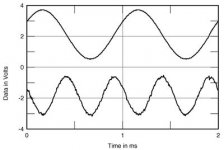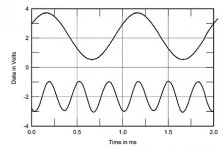But have you used a TO 264 .... in general what is the way to overcome the capacitances.... Just increasing the driver idle current will suffice?
Capacitance is like a Mass. In audio we need to move that mass quickly.
Say you need fast delivery of cargo anywhere from Peterborough to Folkstone (anywhere between two points).
If the cargo is 2-hand size, you can use a moped. Engine the size of a loaf of bread.
If it is a Ton, you need a pickup truck. Engine like a dresser.
If it is say 500 Tons, you need something even larger. Engine the size of a chicken-shed. Heat-sink (radiator) so big you need a stairway to get to the top.
Attachments
There were no bipolar transistors in the amplifier.
If you go through PRR's analysis you see that the capacitance is not
nearly as much as you might imagine. The Cgd is the one that piles up
on you when you parallel lots of devices.
How do we overcome the effect of Cgd. Consider a 100W or 200W F5 to be built as the current F5 Turbo has got about 4 pairs of mosfets and I believe they are driven by a toshiba To220 package transistors. How many mosfets in total a 2sc4793 can drive without any issues. Secondly how is the stability wrt oscillations when paralleling 10 or pairs of mosfets.
Attachments
The bipolars in the F5 Turbo are cascodes. In my book they only count
for shielding the Jfets from voltage, and don't really affect the drive to
the output devices.
But your question nicely segues into another point worth making -
"How do we overcome the effect of Cgd."
Cascoding is an excellent way to remove Cdg and Cds. To the extent
that Vds, Vdg are held constant by a cascode, you are not charging
those capacitances.

for shielding the Jfets from voltage, and don't really affect the drive to
the output devices.
But your question nicely segues into another point worth making -
"How do we overcome the effect of Cgd."
Cascoding is an excellent way to remove Cdg and Cds. To the extent
that Vds, Vdg are held constant by a cascode, you are not charging
those capacitances.

then we need alot of output devices in that case way too higher but is it the way its implimented in x1000?
Looking at the A75 amp the massive output stage was driven with IRF9610 and IRF610 were they sufficient to drive them?
Looking at the A75 amp the massive output stage was driven with IRF9610 and IRF610 were they sufficient to drive them?
Attachments
fact: they made it
fact: they published schematic in article
fact: many made it from schematic
fact : substancial number of specimens is working today still , on owners happiness
so , what could be answer to your question?
go read a book or two , you can even download them for free
fact: they published schematic in article
fact: many made it from schematic
fact : substancial number of specimens is working today still , on owners happiness
so , what could be answer to your question?
go read a book or two , you can even download them for free
Looking at the A75 amp the massive output stage was driven with IRF9610 and IRF610 were they sufficient to drive them?
What is your criteria for "sufficient"?
Here's what's out there. See the measurement section square wave.
Pass Labs X1000 monoblock power amplifier | Stereophile.com
Pass Labs X1000 monoblock power amplifier | Stereophile.com
Im about to close the deal on a nice pair of X1000's (1. edition), Im asking for advice regarding running Magnepan 3.6/R's which is pretty resistive load around 4 ohms,
Should I worry about the age of these beasts, regarding the said rather hot running driver stage. Or maybe as other have pointed out their low damping factor.
My amps today is 2 pcs of NAD 218THX wich I run in vertical biamp config, and low temperatures <50*C.
Seller asking 10K, I think its fair enough if they show to be reliable.
Anyone with experience with the lifespan on these beauties?
Im not listening loud, rearly >+100 dB.
Sorry for OT, not many places to ask.
Best regards
KO
Should I worry about the age of these beasts, regarding the said rather hot running driver stage. Or maybe as other have pointed out their low damping factor.
My amps today is 2 pcs of NAD 218THX wich I run in vertical biamp config, and low temperatures <50*C.
Seller asking 10K, I think its fair enough if they show to be reliable.
Anyone with experience with the lifespan on these beauties?
Im not listening loud, rearly >+100 dB.
Sorry for OT, not many places to ask.
Best regards
KO
Should I worry about the age of these beasts, regarding the said rather hot running driver stage. Or maybe as other have pointed out their low damping factor.
Anyone with experience with the lifespan on these beauties?
I suppose that a DF of 60 is not very high, but as these amplifiers achieve
1000W with only two gain stages there is not a lot of feedback used.
Nevertheless, they deliver 30 amps and I have always thought they
had good control over loads.
As to lifespan, they were introduced in 1996 and I am not aware of any
failures in the field.
Wow I never thought I would get direct reply from the designer of the amp !!I suppose that a DF of 60 is not very high, but as these amplifiers achieve
1000W with only two gain stages there is not a lot of feedback used.
Nevertheless, they deliver 30 amps and I have always thought they
had good control over loads.
As to lifespan, they were introduced in 1996 and I am not aware of any
failures in the field.
Its settled then, just 1500 mile drive to get them
Thank you for your answers 6L6, Zen Mod and mr Pass
Best regards
KO
Here's what's out there. See the measurement section square wave.
Pass Labs X1000 monoblock power amplifier | Stereophile.com
When looking at Fig. 4 (distortion and noise waveform with fundamental notched out) under
Pass Labs X1000 monoblock power amplifier Measurements | Stereophile.com
I note the following:
Despite the superimposed noise signal (possibly due to an older measuring system), it is noticeable that only every second curve has a sine wave character, while the first, third, fifth etc. has a triangular character. What is the reason therefore ? Maybe the kind of VAS-driver stage ?
When looking the same measurements (with fundamental notched out) of aleph 3 (mainly H2) and XA30.5 (mainly H3), there are no such effects and the sine wave character remains - go to the attachments and to the reviews under
Pass Labs Aleph 3 power amplifier Measurements | Stereophile.com
and
Pass Labs XA30.5 power amplifier Measurements | Stereophile.com
Even while listening tests the X1000 always seemed a bit more crispy and harsh to me.
Because I haven't a detailed circuit diagram, follow question rises up:
Is in the front-end only one gain stage in use (folded cascode) according the simplified schematic under
PassDiy
or operates an LTP-stage together with a push pull VAS stage like in use at X250 according the schematic in post #37 under
Pass X250 repair
(according the owner's manual of X250 there is also a folded cascode in use - obviously there are even various versions of X250 on the marked without ".5" and ".8" suffix) ??
Attachments
Last edited:
The front end stage and output stage are completely different between the two series amplifiers. Starting at the input stage with fet vs mosfet and the type of bias in the output stage and configuration of the transistors. The X1000 also had no global feedback so the amps are very different.
- Status
- This old topic is closed. If you want to reopen this topic, contact a moderator using the "Report Post" button.
- Home
- Amplifiers
- Pass Labs
- Passlabs X1000 output stage driven by a To264 transistor?


